360 Systems 2470SD User Manual

Operations Manual
Version 4.08.378
September 2008
Copyright© 2008, 360 Systems
All rights reserved
Printed in the United States of America
100-145-0011-02 Time Delay UM

Table of Contents |
|
Safety Notices .................................................................................................... |
4 |
Safety Terms and Symbols .......................................................................... |
4 |
General Safety Caution............................................................................... |
4 |
Personal Injury Precautions ........................................................................ |
4 |
Product Damage Precautions...................................................................... |
5 |
Product Registration ................................................................................... |
5 |
Product Improvements and Upgrades ......................................................... |
5 |
Trademarks ................................................................................................ |
5 |
Software Copyrights ................................................................................... |
5 |
Introduction....................................................................................................... |
6 |
Time Delay Features .......................................................................................... |
7 |
Installation......................................................................................................... |
8 |
Unpacking................................................................................................. |
8 |
Rack Mounting........................................................................................... |
8 |
Important Installation Notes........................................................................ |
9 |
System Cooling .......................................................................................... |
9 |
Power Conditioning ................................................................................. |
10 |
About Time Delay Software...................................................................... |
11 |
Front Panel Features ........................................................................................ |
12 |
Power ON/OFF button ............................................................................. |
12 |
Indicators................................................................................................. |
12 |
Rear Panel Drawing ................................................................................. |
13 |
Rear Panel Connectors..................................................................................... |
14 |
VBI Lines Captured and Played................................................................. |
14 |
Operations....................................................................................................... |
15 |
The Graphical User Interface .................................................................... |
15 |
Run/Stop Control ..................................................................................... |
16 |
Run ....................................................................................... |
16 |
Stop....................................................................................... |
16 |
Time to Air ............................................................................ |
16 |
Time Delay Setting................................................................................... |
16 |
Time Delay Presets................................................................. |
16 |
Input Configuration .................................................................................. |
17 |
Input Source .......................................................................... |
17 |
Audio Sample Rate Conversion .............................................. |
17 |
Video Format ......................................................................... |
17 |
System Timing ....................................................................... |
18 |
Configure Network .................................................................................. |
19 |
Set Date and Time.................................................................................... |
21 |
Technical Specifications................................................................................... |
22 |
Video Index ............................................................................................. |
23 |
Appendix ......................................................................................................... |
24 |
Audio XLR-3 Connector Pinout................................................................. |
24 |
Serial Control Connector Pinout ............................................................... |
24 |
BNC Connectors ...................................................................................... |
24 |
2 • Broadcast Time Delay |
|

GPI Connector ......................................................................................... |
25 |
System Monitor Outputs and Error Conditions ........................ |
25 |
Testing the GPI System Monitor Outputs................................. |
27 |
System Board Ports................................................................................... |
28 |
Keyboard and Mouse ............................................................. |
28 |
SVGA Ports............................................................................ |
28 |
Unused Ports ......................................................................... |
28 |
Mechanical Drawing........................................................................................ |
29 |
Maintenance .................................................................................................... |
30 |
Fault Diagnostics...................................................................................... |
30 |
Front Panel Indicators............................................................................... |
30 |
Gigabit Ethernet Indicators ....................................................................... |
31 |
Access to Components ............................................................................. |
31 |
Removing the Front Panel ........................................................................ |
31 |
Removing the Top Cover.......................................................................... |
32 |
General Handling Precautions.................................................................. |
32 |
Installing/Removing I/O Cards .................................................................. |
33 |
Video I/O Card ...................................................................... |
33 |
RAID Controller Card............................................................. |
33 |
Accessing the Main System Board............................................................. |
33 |
Analog/Digital Audio Selection................................................................. |
34 |
Audio Level Calibration............................................................................ |
35 |
Program Updates via CD-ROM................................................................. |
36 |
Hard Disk Management ................................................................................... |
37 |
About RAID 5 .......................................................................................... |
37 |
Managing Disk Arrays .............................................................................. |
38 |
Error Notification and Repair .................................................................... |
38 |
Log-In to the RAID Utilities....................................................................... |
40 |
Determining the Condition of the RAID Array........................................... |
41 |
Rebuilding the RAID Array ....................................................................... |
45 |
Replacing a Hard Drive............................................................................ |
46 |
Notices ............................................................................................................ |
47 |
Product Registration ................................................................................. |
47 |
Product Improvements and Upgrades ....................................................... |
47 |
Repair Policy ........................................................................................... |
47 |
Trademarks .............................................................................................. |
47 |
Software .................................................................................................. |
47 |
Regulatory Certificates and Compliance.................................................... |
47 |
Safety..................................................................................... |
47 |
Laser Compliance .................................................................. |
48 |
Laser Safety............................................................................ |
48 |
Radio Interference Compliance................................................................. |
48 |
End User License Agreement............................................................................ |
49 |
Limited Warranty............................................................................................. |
51 |
Index................................................................................................................ |
52 |
Table of Contents • 3
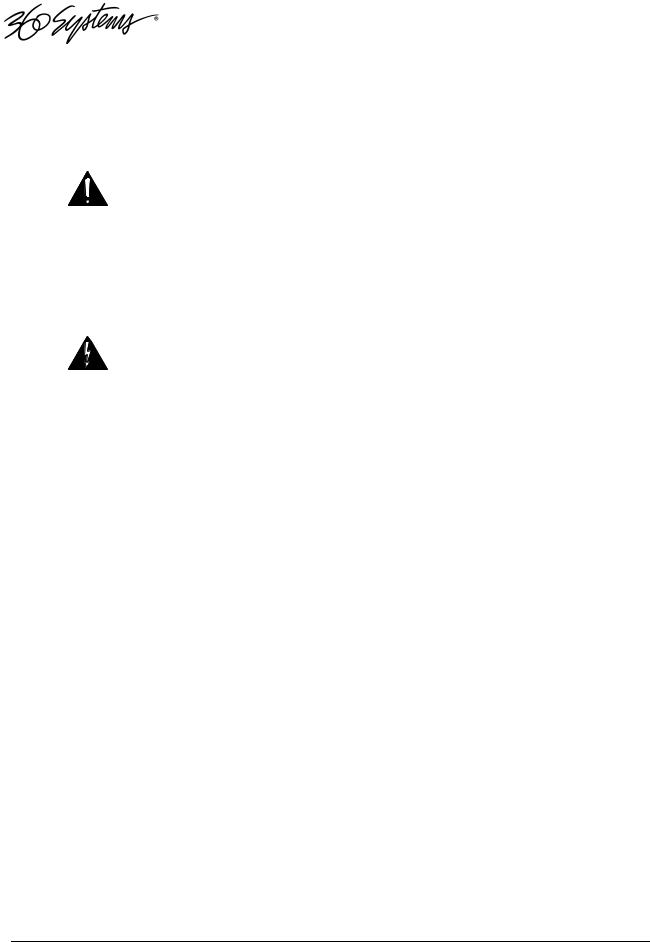
Safety Notices
Safety Terms and Symbols
The following warning symbols are used in this manual
English |
ATTENTION: refer to owner’s manual for important |
|
information. |
Français |
ATTENTION: veuillez vous référer au mode d’emploi pour |
|
une information importante. |
Italiano |
ATTENZIONE: fate riferimento al manuale per informazioni |
|
importanti. |
Español |
ATENTCION: favor de referir al manual de operacion por |
|
informacion importante. |
|
|
English |
WARNING: electrical shock hazard. |
Français |
AVERTISSEMENT: danger de choc électrique. |
Italiano |
AVVERTIMENTO: pericolo di shock elettrico. |
Español |
ADVERTENSIA: peligro de choque electrico. |
General Safety Caution
Heed the following important cautions regarding the Time Delay in order to avoid personal injury or equipment damage.
Only qualified personnel should perform installation and service. Refer to appropriate sections of this product manual for instruction. Contact 360 Systems Customer Support for further explanation, or to clarify any uncertainty.
Disconnect the power cord before removing the cover.
Personal Injury Precautions
To avoid electric shock, do not operate this product with covers removed.
To avoid risk of fire, replace the power cord only with same type and rating as specified. Replace damaged power cords immediately.
This product is grounded through the grounding conductor of the power cord. To avoid electric shock, do not remove or modify the contacts on the plug.
Prevent the power cord from being walked on, pinched, or abraded.
To reduce the risk of fire or electric shock, do not expose this unit to rain or moisture.
Remove jewelry, such as rings, watches, or necklaces before servicing this equipment.
4 • Broadcast Time Delay

Product Damage Precautions
The Broadcast Time Delay contains hard disk drives and other fragile electronic and mechanical devices. While this product is very reliable, it is still vulnerable to shock. Handle it with care, and exercise caution not to drop or bump the recorder as damage to internal components may result. Turn off power before moving the server.
Do not obstruct air vents. Maintain an ambient temperature below 30°C (86°F).
Clean only with a soft cloth dampened with water. Do not spray cleaners or solvents directly on the product.
 CAUTION:
CAUTION:
Replace battery only with the same, or equivalent, battery type. Follow all local laws regarding the disposal of BR and CR Lithium batteries. Batteries should be fully discharged prior to disposal.
 CAUTION:
CAUTION:
Never use the rear-panel power supply switch to shutdown the Time Delay. Doing so may cause errors in the hard disk array. Should this happen, the array can be reinitialized without any data loss; however, the process may take several hours. Shutdown the system only by momentarily pressing the front panel power button, or through the On-Screen user interface.
Product Registration
Important: As the owner of new capital equipment, you will want to take advantage of product information, enhancements, upgrades, or notifications issued by 360 Systems. Send in your Warranty Card so 360 Systems can remain in contact with you. Mail or fax it to 360 Systems offices in the USA at the address given below.
Product Improvements and Upgrades
360 Systems reserves the right to make changes and/or improvements to its products without incurring any obligation to incorporate such changes or improvements in units previously sold. Certain features mentioned in this document may not be present in all models. Time Delays are not offered for sale in all countries.
Trademarks
Image Server, MAXX, Multi-Format Image Server, 360 Systems, 360 Systems Broadcast, 360 Systems Broadcast Time Delay, Bit-for-Bit, and Direct Digital Import are trademarks or registered trademarks of 360 Systems in the U.S. and/or foreign countries. Other trademarks referred to in this document are the property of their respective owners.
Software Copyrights
Software in this product is based on the work of, or is copyright by, 360 Systems, SuSE® GmbH, Trolltech, and FreeType Team. Copyright 2003-2008 by 360 Systems.
Safety Notices 5

Broadcast Time Delay
Introduction
360 Systems’ Broadcast Time Delay is a high-quality program delay for television broadcast, satellite delivery, and other applications requiring a user-settable delay time for video, audio, and vertical interval data. Applications for the delay include:
•Compensation for worldwide time zones differences, where a program is received at a different time than when it needs to air.
•Program origination delays, where content is time-shifted prior to transmission or distribution.
•Time delays of 24 hours. This delay may be used by a broadcaster to provide “evergreen” material in the event of network/satellite transmission problems. In this instance, material received exactly 24 hours earlier could be re-transmitted until problems are resolved.
•“+1” channels that allow cablecasters to offer multiple feeds of the same program content to maximize channel exposure with limited additional cost. Viewers can choose to see a variety of different shows in their chosen viewing time, or see an immediate repeat of a show that interested them simply by changing the channel.
The Broadcast Time Delay can be thought of as a black box that records video, audio, and specific VBI information; it then delays the playback of the program by a user-selectable time period. Whatever goes in, comes out later.
The Broadcast Time Delay will operate as a set-and-forget box with no user intervention. On restarting after a power failure, it will again start delaying the input according to the most recent user settings. The delay time is user-programmable from 20 seconds to greater than 24 hours. The programmed delay interval is frame-accurate over an indefinite time period; if several Broadcast Time Delays are fed identical input signals they will remain in sync indefinitely.
The video channel accepts both Composite (CVBS) and SDI video signals.
Four audio channels are provided, and may be AES/EBU digital, or embedded in an SDI stream. Alternately, two +4 dBu analog channels are available. Audio I/O is on chassis-mounted goldplated XLR-3 connectors.
6 • Broadcast Time Delay

Time Delay Features
•Functions in a stand-alone configuration with no external machine controls, and requires no third-party software.
•Operates unattended for long periods of time. No operator intervention or file maintenance required for continuous operation.
•All settings are non-volatile, allowing unattended restart on power-up. The unit automatically reconfigures itself for the last-specified time delay, and re-enters the record/playback cycle.
•System configuration is accomplished through a GUI interface using a local keyboard, mouse and VGA monitor.
•Allows user to specify a frame-accurate delay time, such that multiple units will play back in frame-accurate sync when fed identical input video.
•RAID-5 hardware-based drive array protects stored data against a single drive failure.
•1 program input, with selectable CVBS or SDI input connection. 1 E-E monitor output, 1 delayed program output. SDI and composite video BNC connectors provided. Each output appears on both SDI and Composite simultaneously.
•Records video in MPEG-2, 4:2:2 profile, 30 Mb I-frame.
•Records user-choice of audio sources: 2 stereo pairs SDI embedded, 2 stereo pairs AES/EBU digital, or 1 stereo pair of +4 analog. XLR-3 connectors are provided on the rear panel.
•Compatible with Dolby®-E and Dolby®-AC-3 audio.
•Captures and plays VITC (Vertical Interval time code).
•Accepts analog video (black burst) reference for genlocked playout.
•Synchronizes to video input upon loss of external reference.
•Upon loss of input video, records black until input is restored.
•Outputs SDI black and audio silence during the recording interval preceding the desired program output delay.
•Captures and plays VBI data. See table.
•Special handling for Video Index data on line 11 in PAL format.
•Front panel status LEDs: power, genlock, RAID status, fan failure, system errors.
•System Monitor signals available from GPI Outputs to indicate RAID status, fan failure, system errors, loss of genlock and loss of input.
•2 rack-unit (3¾”) height. Forced-air cooling. 160 watt power consumption.
Introduction & Features 7

Installation
Unpacking
Your Time Delay has been carefully inspected and calibrated before shipment to allow immediate operation upon installation. Check all items for signs of visible damage which may have occurred during shipment. If any item is damaged, contact the carrier to file a claim.
Keep the packing materials in the event that a unit must be shipped by you. If the original packaging is not available, make sure that the following criteria are met:
•Packaging must be able to withstand the product weight.
•Product must be held firmly within the package.
•There must be at least two inches (50mm) of space between the product and outer container.
•The corners of the product must be protected.
Package Contents
Confirm that all items on the packing list have been received. Contact 360 Systems if any item is missing.
Broadcast Time Delay
Keyboard
2-Button Scroll Mouse.
Software CD-ROM backup copy
Rack Mount Hardware Kit
Operations Manual
Power cord
Warranty Card
The Time Delay is not shipped with a video monitor. Select a VESA-compliant CRT or LCD monitor capable of a refresh rate of at least 75 Hz. Note that the Time Delay may not start correctly if an unsuitable monitor is connected.
If you own more than one Time Delay, it may be appropriate to use a single keyboard, monitor, and mouse with a KVM switch to select between servers. Not all KVM switching systems are compatible. The KVM switch must supply an active signal to the Time Delay at all times, even when switched away from it. When first powering up the Time Delay, use only the supplied keyboard and mouse directly connected. Then test the KVM switch system that will be used thoroughly before installation is completed. NOTE: If the mouse and keyboard connections are interchanged, the Time Delay may not boot up properly. Be especially careful about this when using extender cables.
Rack Mounting
Note: If you plan to use digital audio, be sure to change the configuration of the Analog/Digital Audio Jumpers inside the unit before mounting the Time Delay in a rack. The jumpers are factory set to the Analog audio position. For more information about changing the jumpers, see Analog/Digital Audio Selection on page 34.
8 • Broadcast Time Delay

There are four adhesive-backed rubber feet on the Time Delay. These may need to be removed when rack mounting the unit.
In North America, the Time Delay will usually be mounted in a 19” rack enclosure having 10-24 or 10-32 tapped holes. In countries with metric standards, the user will need to supply appropriate fasteners.
Cables attached to the rear of the Time Delay should be supported by the rack mounting rails. Do not support substantial cable weight from the Time Delay.
Remove the front panel to expose the rack screw slots. Fasten the Time Delay into the rack using #10 flat-head Phillips screws (provided in North America). Replace the front panel. Tighten the front panel access screws.
Important Installation Notes
System Cooling
When many pieces of equipment are mounted in an equipment rack, a considerable amount of heat may be produced, which must be removed efficiently. Further, a lower operating temperature will make equipment operate more reliably, and it will last longer. In the extreme case, excessive temperatures cause rapid equipment failure, and damage which can be difficult to repair.
Heat in an equipment rack should be removed by forced air. This is often accomplished by blowers installed in the top of the rack, venting into the room. An alternative is to draw hot air from the top of the rack into an air-conditioning return duct, and not vent it into the equipment room; cold air should be ducted into the bottom of the rack.
The optimum air temperature for cooling electronic equipment is 25° C (72° F). When many pieces of equipment are contributing to the heat load, a substantial air-flow will be needed, and the inlet temperature may need to be lower.
Check These Points
•Are all ventilation holes in the Time Delay free of obstruction?
•Can blowers or HVAC system adequately remove heat from the equipment rack?
•Have you measured the actual temperature inside the rack? Do this near the top.
•Verify that the HVAC system is not on a timer that can shut off on weekends or holidays.
•What procedures are in place to protect the equipment when the HVAC system fails?
Introduction & Features 9

Important Installation Notes
Power Conditioning
It is good practice to operate an on-air video server from an Uninterruptible Power Source, or UPS. All utility power systems experience occasional transient events, including brownouts and dropouts, which are capable of taking a server off the air. It is the station operator’s job to plan for and overcome such contingencies.
UPS units suitable for smoothing short-term power line problems come in two varieties:
Change-over UPS Design
This design senses drop-outs and low-line voltage, and switches its output to an internal inverter operating from a battery. This UPS is low in cost, and is most often used in non-critical applications such as desk-top computers. A disadvantage is that it may create its own power transients when switching between utility power and its inverter supply. For this reason 360 Systems does not recommend this type for use with Time Delay.
Continuous Conversion UPS Design
This improved design continuously converts utility power to DC, stores it in a battery, then produces isolated AC power from an inverter. It never switches, and is immune to input transients, brownouts, and blackouts. Models are available with batteries of almost any size, making the continuous-conversion UPS suitable for transient suppression or long-term operating power in the absence of utility power.
Recommended UPS Models
The following makes of continuous conversion UPS systems are suitable for use with 360 Systems’ Image Server products:
APC Smart-UPS 2200-XL
Eaton/Powerware Corporation, Model 9125, www.powerware.com
This unit is available in several different configurations to accommodate various current load and power failure support times.
The minimum requirement for maximum current load for a single Time Delay is 2 amps.
Operating Environment
A video server is a most critical element in a broadcast operation. Its installation should safeguard it from every external event that can interfere with it doing the task expected of it. 360 Systems’ engineers have experience with thousands of installations, and have become aware of a number of environmental factors that can adversely affect performance. Two of these have already been discussed: power conditioning and inadequate cooling. Two others, less obvious, should also be considered:
10 • Broadcast Time Delay

Important Installation Notes
RF Interference by Cell Phones
Many people are not aware that cell phones can attain a very substantial power output, even when no conversation is taking place. You may have experienced the effect of a cell phone interfering with a common desk phone placed nearby. Carrying a cell phone into a machine room where it is in close proximity to broadcast equipment and its associated wiring is unwise. They are able to interfere with serial control commands, video synchronization, and in some cases can crash the CPU in equipment.
Some major broadcasters prohibit the carrying of cell phones into certain machine areas. 360 Systems believes that the risk of undesired equipment behavior from their RF fields is very real.
Static Discharge
Static electricity discharge is accepted by most people as an inevitable consequence of living in a dry area. It is, rather, a result of floor coverings that may enhance appearances, but are inappropriate for use around critical pieces of broadcast equipment. Static discharge can do two adverse things:
•Discharge into a connector can—and will—destroy internal circuitry of equipment. The result will always be difficult to diagnose and repair.
•Discharge to equipment frames or wiring can crash a CPU and take the station off the air. The event may seem random or unrelated to static, but it is clearly a catastrophic event—and one that can repeat indefinitely as humidity varies.
Several steps can be taken to protect equipment from static discharge:
•Do not install critical broadcast equipment (video servers) in a room with carpeting.
•Connect equipment racks directly to an earth ground with a heavy copper conductor.
•Do not operate equipment with a lifted safety ground (green frame ground).
•Install a humidifier to reduce the level of static discharge.
About Time Delay Software
The Time Delay is shipped with its application programs and operating system installed.
The first time that it is started, it must be connected to a keyboard, monitor and mouse. The Time Delay will ask you to accept the Software Licensing Agreement before it will operate. This screen will only appear during the initial startup.
The CD-ROM drive is intended only for installing software. It may not be used to load video or audio program content.
If for any reason it becomes necessary to reinstall any software, refer to the Maintenance chapter on page 36 for instructions.
Introduction & Features 11
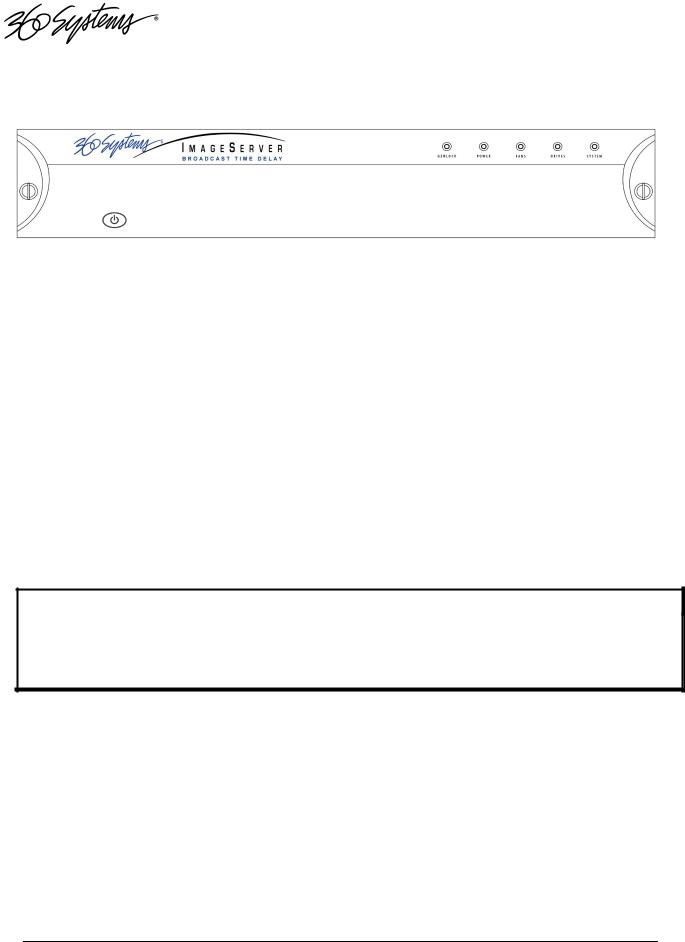
Front Panel Features
Power ON/OFF button
The blue front panel button initiates start-up and shut-down of the Broadcast Time Delay. Press it momentarily to start the server. A sequence of start-up screens will appear, ending with the 3-channel graphic user interface.
When the Broadcast Time Delay is running, pressing the blue button momentarily will cause the system to begin an orderly shutdown. This can also be initiated from the GUI by selecting START > SHUTDOWN > SHUTDOWN. In most cases the power will shut off automatically,
however if the front panel lights begin to blink the file system has been properly closed and it is safe to force the power off by holding the front panel button in for 4 seconds.
In the event that the system has stopped responding to commands and will not shutdown, hold the button in for 4 seconds to force a power down.
Do not use the rear panel switch on the power supply to shut down the Broadcast Time Delay. Abrupt power loss can cause loss of information stored on the disk array. The rear panel power switch can be used to prevent re-application of power during service procedures once the normal shut down sequence is complete.
CAUTION:
LOSS OF DATA CAN OCCUR IF THE POWER IS TURNED OFF WITHOUT A SHUTDOWN.
USE THE FOUR SECOND SHUTDOWN ONLY IF THE SYSTEM IS NOT RESPONDING OR THE SHUTDOWN PROCESS DOES NOT TURN THE POWER OFF AUTOMATICALLY.
Indicators
Five blue LED Status Indicators appear on the front panel. These indicators are illuminated continuously when the system is functioning normally. See the table Front Panel Indicators on page 30 for diagnostic meanings.
The Status Indicators are also available as GPI outputs, along with additional output warnings for loss of input and loss of genlock. See GPI Interfacing for details.
12 • Broadcast Time Delay
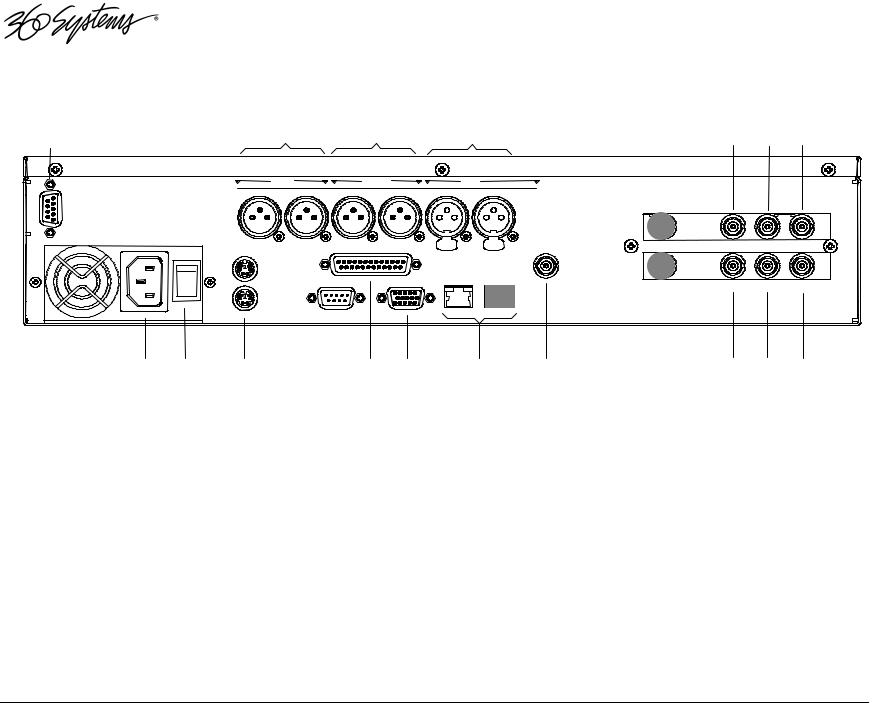
Rear Panel Drawing
1 |
2 |
|
3 |
4 |
|
5 |
6 |
7 |
OUTPUT |
MONITOR |
INPUT |
|
|
|
|
||
MAIN L |
MAIN R |
MAIN L |
MAIN R |
MAIN IN L |
MAIN IN R |
ANALOG |
|
|
MAIN L/R |
AUX L/R |
MAIN L/R |
AUX L/R |
MAIN IN L/R |
AUX IN L/R |
DIGITAL |
|
|
100 - 240 VOLTS, 50 - 60Hz, 2 AMPS MAX |
|
|
|
CVBS |
CVBS |
CVBS |
|
|
GPI |
|
OUT |
MON |
IN |
|
|
|
|
GENLOCK |
|
|
|
MOUSE |
|
|
INPUT |
|
|
SERIAL |
|
|
NET 1 |
|
|
|
SERIAL |
MONITOR |
GIGABIT LAN |
SDI |
SDI |
SDI |
|
CONTROL |
|
|||||
|
|
|
OUT |
MON |
IN |
|
|
KEYBD |
|
|
|
|
|
|
8 |
9 |
10 |
12 |
13 |
14 |
15 |
16 |
17 |
18 |
|
|
|
11 |
|
|
|
|
|
|
|
1. |
Serial control port (EIA-422) |
|
|
9. |
AC Power switch |
|
|
|
||
2. |
(2) XLR-3 audio outputs (AES/EBU digital |
|
|
10. |
Mouse port |
|
|
|
||
|
or +4 balanced analog) |
|
|
|
11. |
Keyboard port |
|
|
|
|
3. |
(2) XLR-3 audio monitors (AES/EBU digital |
|
|
12. |
GPI port, 25-pin female |
|
|
|
||
|
or +4 balanced analog) |
|
|
|
13. |
SVGA monitor port |
|
|
|
|
4. |
(2) XLR-3 audio inputs (AES/EBU digital |
|
|
14. |
Gigabit Ethernet ports |
|
|
|
||
|
or +4 balanced analog) |
|
|
|
|
(Use NET1 only.) |
|
|
|
|
5. |
Composite video main output |
|
|
15. |
Genlock Input |
|
|
|
||
6. |
Composite video EE monitor output |
|
|
16. |
SDI video main output |
|
|
|
||
7. |
Composite video input |
|
|
|
17. |
SDI video EE monitor output |
|
|
|
|
8. |
AC Power connector |
|
|
|
18. |
SDI video input |
|
|
|
|
Introduction & Features 13

Rear Panel Connectors
The Broadcast Time Delay provides one video input with up to four audio channels, one delayed video output with audio, and a second monitoring output which reflects input video and audio (E- E), and can be used as a confidence-monitor.
XLR In 1L |
(AES/EBU Ch. 1/2) |
Main program input 1 |
XLR In 1R |
|
Main program input 2 |
XLR In 2L |
(AES/EBU Ch. 3/4) |
Aux program input 3 |
XLR In 2R |
|
Aux program input 4 |
XLR Mon Out 1L |
(AES/EBU Ch. 1/2) |
Main E-E monitor out 1 |
XLR Mon Out 1R |
|
Main E-E monitor out 2 |
XLR Mon Out 2L |
(AES/EBU Ch. 3/4) |
Aux E-E monitor out 3 |
XLR Mon Out 2R |
|
Aux E-E monitor out 4 |
XLR Pgm Out 1L |
(AES/EBU Ch. 1/2) |
Main program out 1 |
XLR Pgm Out 1R |
|
Main program out 2 |
XLR Pgm Out 2L |
(AES/EBU Ch. 3/4) |
Aux program out 3 |
XLR Pgm Out 2R |
|
Aux program out 4 |
BNC SDI 1 In |
|
SDI program Input |
BNC SDI Mon Out |
|
SDI E-E monitor out |
BNC SDI Out |
|
SDI program out |
BNC CVBS 1 In |
|
CVBS program Input |
BNC CVBS Mon Out |
|
E-E monitor out |
BNC CVBS Out |
|
CVBS program out |
BNC Genlock |
|
Genlock input |
BNC LTC In |
|
Longitudinal time code in |
BNC LTC Out |
|
Longitudinal time code out |
DB-25 GPIO |
|
Error Monitor Outputs |
DB-9 Serial In |
|
future use |
Motherboard I/O |
|
future use |
VBI Lines Captured and Played
The Broadcast Time Delay records and passes through all VBI lines between 11 and 22 (inclusive, field 1 and corresponding lines in field 2) in both NTSC and PAL. Following are examples of recorded VBI data, along with their typical1 line locations:
Line 11: PAL Video Index (PAL only – special processing enabled by default. See page 23.) Line 12-22: Teletext (PAL – also line 11 if Video Index is disabled.)
Line 14 & 16: VITC
Line 19: Wink Data (Interactive TV) Line 20, 22: AMOL (Nielson data) Line 21: Closed captioning
Line 23 WSS (PAL)
1 With the exception of Video Index, the Time Delay can reproduce these signals on any VBI line.
14 Broadcast Time Delay
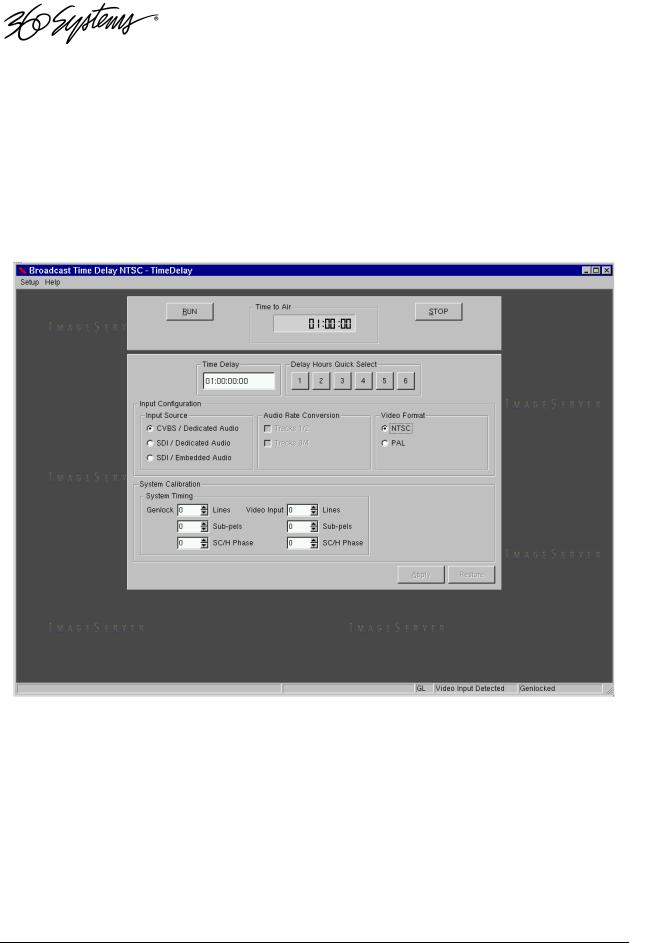
Operations
The Graphical User Interface
The Broadcast Time Delay uses a Graphical User Interface (GUI) to control most functions. A keyboard and mouse are included, and the user needs to supply an SVGA monitor—either CRT or flatpanel.
The GUI is divided into four sections: Run/Stop control, Time Delay Set, Input Configuration, and System Calibration. Controls and displays for each section are described below.
Graphical User Interface
Operations 15
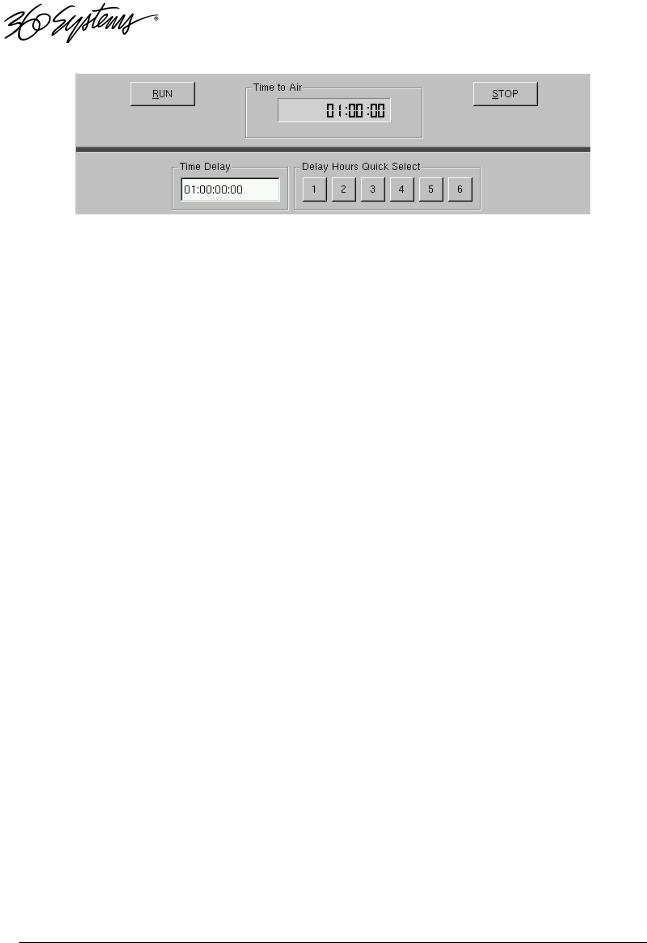
Run, Stop, Time to Air display
Time Delay and Time Delay Presets
Run/Stop Control
Run
The RUN button initiates or restarts the time delay process.
Stop
The STOP button stops playout and clears stored program content from memory. Note that the Time Delay value can only be changed when the machine is in the STOP mode. Press RUN to begin a new delay cycle, and restart the Time-to-Air countdown.
Time to Air
Time to Air is a countdown value, displaying the time remaining before delayed program material reaches the output. It is an approximate display value; it is not directly locked to the video timing.
Time Delay Setting
Delay time is entered and displayed in the DELAY TIME window in D.HH:MM:SS:FF format. (Day.Hours:Minutes:Seconds:Frames) The desired time is entered from the keyboard from left-to- right.
Delay times may also be entered as whole units of seconds, minutes, hours, or days by appending a suffix, (s, m, d, or h) to the value entered into the text box, such as “120m” or “30s.”
Time Delay Presets
Six preset buttons provide a rapid way to set a delay time to an even number of hours from 1 to 6. With the machine stopped, clicking on one of these buttons will immediately load that time value, expressed in hours. An appropriate number of zeros will also be entered for MM:SS:FF. The presets are not active while the machine is running.
16 Broadcast Time Delay
